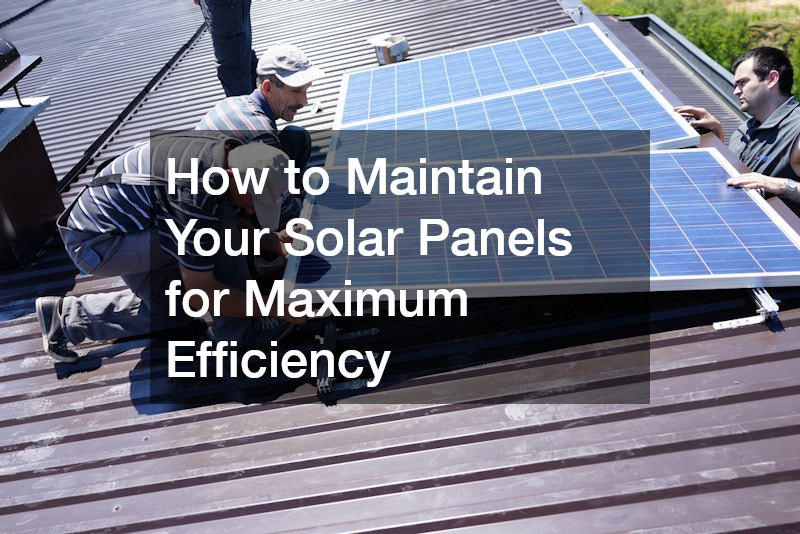With the increasing shift towards sustainable energy, more Australians are investing in solar panels to power their homes and businesses. These systems not only reduce electricity bills but also contribute to a cleaner environment.
However, like any significant investment, solar panels require consistent maintenance to perform at their best. Proper care can enhance their efficiency, prolong their lifespan and ensure you get the best return on your investment. Understanding how to maintain your system is crucial for keeping it operating at peak performance throughout its lifetime.
Understanding the Importance of Maintenance
Solar panels are built to be durable, with most systems designed to last 20 to 30 years. Still, exposure to the elements such as dust, pollen, bird droppings and leaves can reduce their efficiency over time. While rain can assist with some basic cleaning, it’s not sufficient for ensuring optimal output. A regular inspection and cleaning schedule can make a substantial difference in how much power your system generates. If panels become dirty or shaded, the sunlight they capture is reduced, lowering energy output and, in turn, savings on your electricity bills.
Moreover, neglecting maintenance could lead to undetected issues, such as microcracks, corrosion or loose wiring, which may compromise system integrity. Addressing minor problems early can prevent costly repairs or replacements down the track. This proactive approach to care helps safeguard your financial and environmental investment in renewable energy.
Routine Cleaning Techniques
Cleaning your solar panels doesn’t require high-tech tools or complicated methods. Most residential systems can be safely cleaned with water, a non-abrasive sponge or cloth and mild soap. It’s best to carry out this task early in the morning or late in the afternoon when panels are cool, to avoid cracking from sudden temperature changes and to prevent water from evaporating too quickly.
Accessing rooftop panels can pose a safety risk, so take care when climbing ladders or walking on sloped surfaces. If you’re uncertain or uncomfortable with heights, hiring a professional cleaner with the right safety gear and experience is highly recommended. For ground-mounted systems, cleaning is more straightforward, but the same gentle techniques should be applied.
It’s essential to avoid high-pressure washers or harsh chemicals, as these can damage the surface of the panels or strip away protective coatings. A soft-bristled brush or rubber squeegee can help remove stubborn debris without scratching the panels. Be sure to rinse thoroughly to leave no soapy residue, which can cause cloudiness and reduce light absorption.
Scheduling Inspections & System Checks
In addition to cleaning, scheduling regular inspections ensures your solar system is operating correctly. While many homeowners assume that panels will continue working effectively without issue, environmental factors or mechanical faults can affect performance. An annual professional inspection can identify and resolve problems early, whether it’s a fault in the inverter, corrosion at connection points or water ingress in panel casings.
Monitoring your system’s energy output through a solar monitoring app or inverter display can also provide insights. If you notice an unexpected drop in energy production, it may signal an issue needing attention. Systematic reviews of your electricity usage versus output can help you determine whether your panels are performing as expected.
In bushfire-prone areas or locations with heavy tree coverage, more frequent checks may be necessary. Accumulated ash, soot or falling branches can damage or obscure panels. Similarly, regions prone to high winds or hail should check for any physical damage following extreme weather events.
Maintaining the Surrounding Environment
Maximising solar efficiency also involves managing the environment around your panels. Ensure no new trees or buildings are casting shadows on the system, particularly during peak sunlight hours. Shade can significantly decrease the output of even a few affected cells, especially if the system lacks microinverters or optimisers that manage individual panel performance.
Pests and vermin can damage wiring, particularly when nesting in or around electrical components. A pest inspection as part of your regular maintenance schedule can help mitigate this risk, especially in rural or wooded areas.
Professional Maintenance Services
While many basic maintenance tasks can be performed by homeowners, there is undeniable value in hiring professionals to handle more technical or hazardous tasks. Professional services can include thermal imaging to detect faulty cells, electrical testing for voltage irregularities and structural inspections for mounting integrity. Engaging a qualified technician annually ensures your solar panels continue to operate safely and efficiently.
Additionally, if your solar panels are under warranty, certain maintenance tasks might be required to keep the warranty valid. Always refer to your installer’s guidelines and warranty documents to ensure compliance.
Powering the Future with Reliable Maintenance
Maintaining your solar panels for maximum efficiency is essential to harnessing the full benefits of renewable energy. Consistent cleaning, routine inspections, environmental management and professional servicing all contribute to optimal performance and long-term durability. By adopting a proactive approach to solar panel care, you not only increase the energy output and financial savings of your system but also extend its operational life.
Solar energy represents a significant step toward a more sustainable future. Ensuring that your solar panels continue to function effectively plays a key role in maximising that future’s potential. Regular maintenance is more than just upkeep—it’s a commitment to reliable, clean energy for years to come.
.

